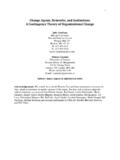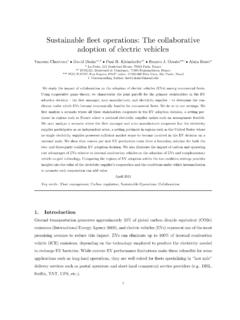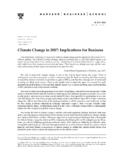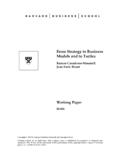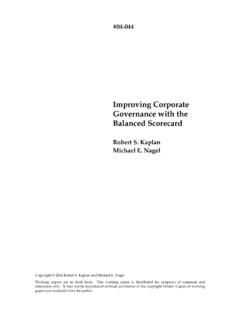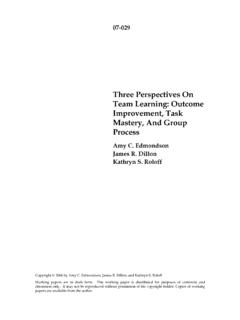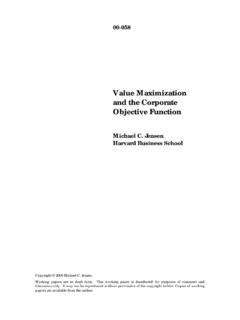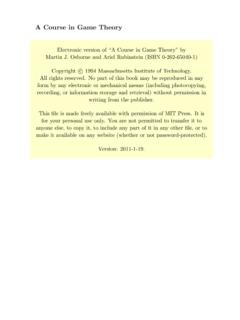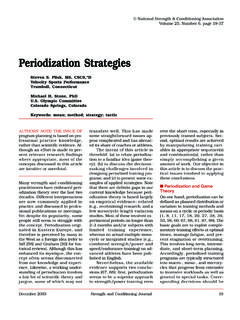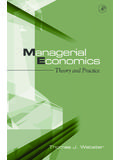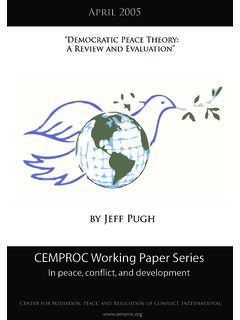Transcription of Elevating Repositioning Costs: Strategy Dynamics …
1 Copyright 2014 by Anoop R. Menon and Dennis A. Yao Working papers are in draft form. This working paper is distributed for purposes of comment and discussion only. It may not be reproduced without permission of the copyright holder. Copies of working papers are available from the author. Elevating Repositioning Costs: Strategy Dynamics and competitive interactions in Grand Strategy Anoop R. Menon Dennis A. Yao Working Paper 14-103 April 17, 2014 Elevating Repositioning Costs: Strategy Dynamics and competitive interactions in Grand Strategy Anoop R.
2 Menon and Dennis A. Yao1 April 17, 2014 Abstract This paper proposes an approach for modeling strategic interactions that incorporates the costs to firms of changing their strategies. The costs associated with Strategy modifications, which we term Repositioning costs, constitute a defining feature of strategic choice which is particularly relevant to interactions involving grand strategies. Repositioning costs can critically affect competitive Dynamics by making strategies sticky and, consequently, the implications of strategic interaction for strategic choice.
3 And yet, while the organization and Strategy literatures broadly recognize the importance of Repositioning costs, game-theoretic treatments at the grand Strategy level with very limited exceptions have not focused on them. In this paper we argue for greater recognition of Repositioning costs, provide a Repositioning cost typology, and demonstrate the fertility of this approach with a simple model of inter-firm competitive interaction in which Repositioning costs increase with the length of time that a firm has been executing its current Strategy .
4 1 The Wharton School, University of Pennsylvania, Philadelphia, PA 19104, and Harvard Business School, Boston, MA 02163, The authors thank Pankaj Ghemawat, Hillary Greene, Rich Makadok, David Yoffie and seminar participants at HBS and the CRES Conference on the Foundations of Business Strategy , Washington University, for helpful comments.
5 Elevating Repositioning Costs 2 1. Introduction Strategic change is daunting. To go all in requires a commitment to developing new capabilities and integrating those capabilities across the activity system of the firm, while abandoning existing systems that either do not support or actively undermine the strategic change. The costs involved with such change what we call Repositioning costs can be analyzed from the viewpoint of the focal firm itself, but a full assessment of the benefits of strategic change requires, among other things, assessing future moves and countermoves of the focal firm and its rivals.
6 Understanding these strategic Dynamics , especially when assessing grand Strategy , requires consideration of Repositioning costs. This paper constitutes an initial attempt to both elevate and formalize the role of Repositioning costs within analyses of grand Strategy . The approach proposed incorporates Repositioning costs into game theoretic models of grand Strategy . The Repositioning costs we contemplate include those associated with strategic changes to a firm s market position or its configuration. Such costs reflect a change to a firm s activity system (Porter, 1996) and reflect myriad factors including the similarity between the old and new activity systems, the length of time during which the previous activity system was employed, and the difference in the resources needed to support each position.
7 Repositioning costs are, therefore, path Our focus on Repositioning costs reflects Pankaj Ghemawat s perspective on commitment as Strategy (Ghemawat, 1991). He persuasively argues that a strategic choice is one that involves commitment. Because strategic choices necessarily entail revising prior commitments, all such choices involve Repositioning costs. As such, Repositioning costs are critical factors shaping strategic interaction at the grand Strategy level. Incorporating Repositioning costs into conventional game-theoretic models requires explicit assumptions regarding costs associated with shifting from one activity system to another.
8 A voluminous literature exists, primarily in economics, that explores the varied mechanisms through which commitment operates and includes topics such as entry, pricing, and capacity expansions. While employing the same methodology as this research, our approach differs owing to its emphasis on exploring general Repositioning cost structures associated with changes in higher-level or grand Strategy rather than on specific costs that firms incur as part of commitments made below the level of grand Strategy . The next section explains why Repositioning costs are central to understanding Strategy Dynamics and argues that such costs generally should be included in models addressing strategic change.
9 We also situate our idea in the Strategy , organization, and economics literatures. Section 3 proposes a typology of the Repositioning costs. Section 4 presents a simple example that 2 Ghemawat (1991) notes that many define Strategy as a broad pattern of behavior that persists over time. Activity systems have the characteristic of generating such patterns.
10 Elevating Repositioning Costs 3 illustrates how Repositioning costs can be incorporated in a game-theoretic model of strategic Dynamics and explains the value of including those costs. Section 5 discusses the endogeneity of Repositioning costs and the value of game-theoretic models for developing strategic advice. Section 6 concludes. 2. Repositioning costs and commitment in various literatures To position our ideas within the broader literature, we first clarify the context at issue and define key terms. Our focus is on how a firm s Strategy may change over time in anticipation of and in response to competitors Strategy choices.
